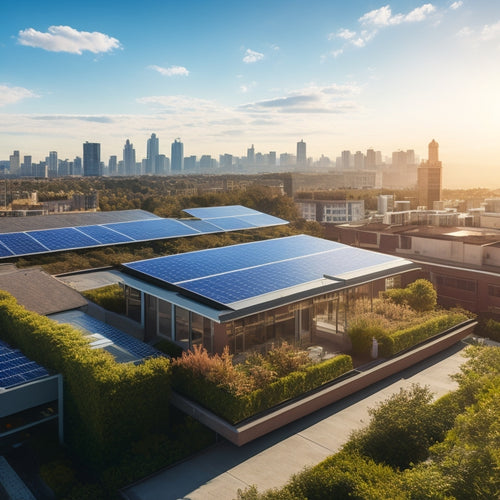
Best Solar Panels for Homes in Texas
Share
As you investigate the best solar panels for your Texas home, you'll find top brands like SunPower and Panasonic offering high-efficiency modules that maximize energy production. Budget-friendly options like Trina and Hanwha Q CELLS provide reliable performance. With prices ranging from $2.50 to $3.50 per watt, understanding Texas-specific regulations, incentives, and installation factors is essential. Prioritizing high energy efficiency, durability, and thorough warranties will guarantee peak performance and savings. As you weigh your options, you'll want to take into account the unique factors that impact your energy needs and investment goals - and there's more to uncover that can help you make an informed decision.
Key Takeaways
- High-efficiency solar panels from brands like SunPower and Panasonic are ideal for Texas homes, offering optimal energy production and savings.
- Budget-friendly options like Trina and Hanwha Q CELLS provide reliable performance, making solar energy more accessible to Texas homeowners.
- Selecting panels with high energy efficiency ratings (up to 23%) is crucial for maximizing energy production and savings in Texas's sunny climate.
- Texas homeowners should prioritize panels with comprehensive warranties (at least 25 years) and strong customer support for optimal system performance and protection.
- Monocrystalline panels are suitable for small roofs, while bifacial panels can enhance energy production by absorbing light from both sides, making them ideal for Texas homes.
Top Solar Panel Brands
When it comes to utilizing Texas's abundant sunshine, your solar panel brand choice plays a significant role in the overall performance and longevity of your system.
You'll want to invest in top solar technologies that can leverage the Lone Star State's impressive solar irradiance. Leading solar panel brands, like SunPower and Panasonic, offer high-efficiency modules that maximize energy production.
These brands are known for their rigorous testing and quality control, ensuring their products can withstand Texas's extreme weather conditions. In contrast, budget-friendly options like Trina and Hanwha Q CELLS provide reliable performance at a lower cost.
When making your decision, consider factors like warranty duration, temperature coefficient, and module efficiency.
Solar panel comparisons can be overwhelming, but focusing on these key aspects will help you narrow down your options. By selecting a reputable brand, you'll be confident in your system's ability to generate clean energy and save you money on your electricity bills.
Ultimately, the right solar panel brand will help you access the full potential of Texas's solar resources.
Texas-Specific Solar Regulations
You'll need to traverse Texas-specific regulations to guarantee a smooth solar panel installation process.
Key considerations include the state's net metering laws, which govern how you'll be credited for excess energy produced, as well as interconnection standards that dictate how your system connects to the grid.
Additionally, you'll want to understand Texas' renewable energy goals, which can impact incentives and policies supporting solar adoption.
Net Metering Laws
As Texas residents contemplate utilizing the power of solar energy, understanding the state's net metering laws is vital to maximizing their investment. Net metering allows homeowners to generate their own electricity and export any excess to the grid, offsetting their consumption and reducing their bills.
The benefits of net metering are clear: it provides a reliable source of clean energy, reduces reliance on the grid, and can even lead to credit for excess energy produced.
However, there are also challenges to reflect upon. For instance, the state's net metering laws can be intricate, with varying requirements and regulations depending on the utility company and local government.
Additionally, some utilities may impose fees or restrictions on net metering customers, which can impact the overall cost-effectiveness of the system.
To maneuver through these intricacies, it's important to research and understand the specific net metering laws and regulations in your area, ensuring you can reap the full benefits of your solar investment.
Interconnection Standards
In Texas, interconnection standards play an essential role in guaranteeing that solar panel systems are safely and efficiently connected to the grid. As a homeowner, you need to understand these standards to guarantee a smooth and compliant installation process. The interconnection requirements outlined by the Public Utility Commission of Texas (PUCT) are designed to secure grid compatibility and prevent any disruptions to the electrical grid.
| Interconnection Standard | Requirement | Description |
|---|---|---|
| Voltage | 120/240V | The standard voltage for residential solar panel systems |
| Frequency | 60Hz | The standard frequency for residential solar panel systems |
| Grounding | IEEE 1547 | The standard grounding requirement for residential solar panel systems |
| Monitoring | Real-time monitoring | Real-time monitoring is required to secure grid compatibility and detect any issues |
You should guarantee that your solar panel system meets these interconnection requirements to avoid any delays or penalties during the installation process. By understanding these standards, you can rest assured that your solar panel system is safely and efficiently connected to the grid, providing you with clean and reliable energy.
Renewable Energy Goals
Texas has set ambitious renewable energy goals, aiming to generate at least 10,000 megawatts of solar power by 2025, with a long-term vision of becoming a national leader in clean energy production.
As you consider investing in solar panels for your home, it's vital to understand the state's commitment to renewable energy. You'll benefit from the solar energy benefits, including reduced greenhouse gas emissions and lower energy costs. The state's renewable energy goals are driven by advancements in renewable technology, making solar energy more efficient and cost-effective.
You'll be contributing to Texas's goal of becoming a clean energy leader by investing in solar panels. The state's renewable portfolio standard (RPS) requires utilities to generate a certain percentage of their electricity from renewable sources, which creates a market for solar energy.
As a homeowner, you'll be supporting the growth of the solar industry, driving further innovation and reducing carbon emissions. By installing solar panels, you'll not only reduce your energy bills but also contribute to a cleaner, more sustainable future for Texas.
Energy Efficiency Ratings
Your solar panel's energy efficiency rating considerably impacts its ability to generate power from the abundant Texas sunshine. As a homeowner, you want to maximize your energy production while minimizing your energy consumption. A higher energy efficiency rating guarantees you get the most out of your solar panels, reducing your reliance on the grid and increasing your potential for solar rebates.
Here's a breakdown of energy efficiency ratings for top solar panel brands in Texas:
| Brand | Energy Efficiency Rating | Power Output (W) |
|---|---|---|
| Panasonic | 22.1% | 330 |
| SunPower | 22.8% | 440 |
| Tesla | 21.5% | 400 |
| LG | 20.5% | 395 |
| Trina | 20.3% | 380 |
When selecting solar panels, look for high energy efficiency ratings to guarantee you're getting the most power per hour of sunlight. A higher rating means more energy production and a greater potential for savings on your electricity bill.
Cost of Solar Panels
Solar panel prices in Texas vary widely, ranging from $2.50 to $3.50 per watt, depending on the quality and brand of the equipment.
When considering solar panels for your home, you'll need to factor in the total cost of the system, which includes the panels themselves, installation costs, and other expenses. A typical residential solar panel system in Texas can range from $15,000 to $30,000 or more, depending on the size of the system and the quality of the equipment.
You'll also need to think about solar panel financing options, which can help make the upfront cost more manageable. Many solar panel installers offer financing options, such as loans or power purchase agreements, that can help you spread the cost over time.
Additionally, you may be eligible for federal and state tax incentives, which can help offset the cost of the system. When calculating the total cost of solar panels, be sure to factor in installation costs, which can range from $2,000 to $5,000 or more, depending on the complexity of the installation.
Best Panels for Small Homes
Compact residential spaces require efficient energy solutions, and the right solar panels can make a significant difference. When it comes to small homes, you need solar panels that can maximize energy production despite limited roof space.
You'll want to focus on solar panel types that offer high power density, allowing you to generate more energy per square foot. For small homes, consider monocrystalline or bifacial solar panels.
These types of panels are designed to provide higher energy output while taking up less space. Monocrystalline panels, in particular, are known for their high efficiency rates, making them ideal for small roofs. Bifacial panels, on the other hand, can absorb light from both the front and back sides, increasing energy consumption.
When selecting solar panels for your small home, also consider your energy consumption patterns. If you have high energy demands, you may want to opt for panels with higher wattage output.
High-Efficiency Solar Options
With increasing energy demands and limited roof space, homeowners in Texas are seeking high-efficiency solar options to maximize their energy production.
You're likely looking for solar panels that can generate the most power per hour of sunlight. High-efficiency solar panels are designed to convert more sunlight into electricity, making them ideal for homes with limited roof space.
When shopping for high-efficiency solar panels, you'll want to look for models with high power ratings (measured in watts) and high efficiency ratings (measured as a percentage).
These models often feature advanced solar panel technology, such as bifacial panels or PERC cells, which allow them to capture more energy from the sun. For example, some high-efficiency models can achieve efficiency ratings of up to 23%, compared to standard panels which typically range from 15% to 18%.
Durability and Warranty
Frequently, homeowners in Texas overlook an important aspect of solar panels: durability and warranty. When investing in a solar panel system, you want to guarantee it will withstand the harsh Texas climate and last for decades to come.
That's why panel longevity and material resilience are vital factors to evaluate. Look for solar panels with a durable design, sturdy frame, and high-quality materials that can resist corrosion and extreme weather conditions.
A thorough warranty is also essential, as it protects your investment and provides peace of mind. You should opt for solar panels with a warranty that covers both the product and performance for at least 25 years.
This guarantees that you're covered in case of any defects, malfunctions, or unexpected degradation in energy output. By prioritizing durability and warranty, you can enjoy a reliable and efficient solar panel system that generates clean energy for years to come.
Installation and Maintenance
When installing solar panels on your Texas home, you'll want to take into account system design factors like roof size, orientation, and shading to guarantee peak energy production.
Regular panel cleaning schedules will also be vital to maintain efficiency, with the frequency depending on your region's climate and environmental conditions.
Additionally, it's important to understand the warranty and support offered by your chosen manufacturer and installer to secure timely maintenance and repairs.
System Design Considerations
Optimal system design is crucial to utilizing the full potential of your solar panel system in Texas. As you evaluate your system, you'll want to ascertain it's optimized for maximum energy production.
When designing your system, you'll need to reflect on the following key factors:
-
Solar panel orientation: The direction and angle of your panels will impact energy production. In Texas, a south-facing orientation with a tilt between 25-35 degrees is optimal.
-
System size calculation: Your system size will depend on your energy needs, roof size, and local building codes. A professional installer will help you determine the correct size for your system.
-
Shading analysis: Shading from trees, buildings, or other obstructions can greatly reduce energy production. Your installer will assess your property's shading patterns to optimize panel placement.
- Inverter selection: The inverter converts DC power from your panels to AC power for your home. Choose an inverter that matches your system's size and energy requirements.
Panel Cleaning Schedules
After optimizing your system design, it's time to contemplate the ongoing maintenance needs of your solar panel system.
An important aspect of maintenance is cleaning your solar panels regularly to guarantee maximum energy output. You'll want to establish a cleaning frequency that suits your environment and climate. In Texas, where dust and debris are common, it's recommended to clean your panels every 6-12 months. However, if you live in a dusty or polluted area, you may need to clean them more frequently.
When cleaning your panels, use a soft-bristled brush and a mild detergent to avoid damaging the surface. Avoid using harsh chemicals or abrasive materials that can scratch the panels. It's also vital to rinse the panels thoroughly to prevent soap residue from accumulating.
Additionally, consider investing in an automated cleaning system, which can considerably reduce maintenance time and effort. By following these maintenance tips, you'll be able to maximize your solar panel's energy output and extend its lifespan.
Warranty and Support
Because your solar panel system represents a significant investment, you'll want to verify that it's backed by a thorough warranty and dedicated support. A detailed warranty guarantees that you're protected against defects, malfunctions, and other issues that may arise during the system's lifespan.
When evaluating warranty and support options, consider the following key aspects:
-
Warranty coverage: Look for a warranty that covers the entire system, including panels, inverters, and other components, for at least 25 years.
-
Customer service: Confirm the company provides 24/7 customer support, with a dedicated team to handle any issues or concerns.
-
Maintenance and repair: Check if the company offers scheduled maintenance and repair services to keep your system running at peak levels.
- Performance guarantees: Opt for a warranty that guarantees a minimum level of energy production, confirming you get the most out of your solar panel system.
Texas Solar Incentives
Installing solar panels on your Texas home can be a cost-effective decision, especially with the attractive incentives offered by the state and federal governments.
As a homeowner, you're eligible for significant savings that can offset the upfront cost of solar panel installation.
One of the most substantial incentives is the federal tax credit, which allows you to claim 26% of the total solar panel system cost as a credit on your federal income taxes. This can translate to thousands of dollars in savings.
Moreover, many local utility programs in Texas offer rebates and incentives for homeowners who install solar panels. For example, some utilities offer a one-time rebate of $1,500 to $2,000 for solar panel installations.
In addition, Texas has a property tax exemption for solar panels, which means you won't pay additional property taxes on the increased value of your home due to the solar panel installation.
Frequently Asked Questions
Can I Install Solar Panels on My Roof if It's Shaded?
You can install solar panels on a shaded roof, but you'll generate less solar energy. Shaded areas reduce energy output, so you'll need more panels or higher-efficiency ones to meet your power needs.
Do Solar Panels Work During a Power Outage?
You're wondering if solar panels work during a power outage. Typically, they don't, as they're grid-tied and shut off for safety reasons. However, with solar battery storage, you can achieve grid independence, ensuring you have power even when the grid doesn't.
Can I Sell Excess Energy Back to the Grid?
You're likely aware that the US grid has already absorbed over 2 million solar-powered homes; now, you're wondering if you can sell excess energy back to the grid. With net metering benefits and energy buyback options, you can indeed do so, offsetting your utility bills and maximizing your ROI.
Will Solar Panels Void My Roof's Warranty?
When you install solar panels, you're likely wondering if it'll void your roof's warranty. Fortunately, most manufacturers won't void your warranty if you follow their roof warranty considerations during solar panel installation, ensuring a hassle-free process.
Can I Install Solar Panels on a Metal Roof?
You can install solar panels on a metal roof, leveraging its advantages like durability and waterproofing. However, consider specific installation requirements, such as specialized clamps and flashing, to guarantee a secure and watertight attachment.
Related Posts
-

Master Advanced Solar Panel Design Online for Free
You can master advanced solar panel design online for free by leveraging specialized courses and training platforms, ...
-

What Is the Cost to Put in Solar Panels
You're likely considering solar panels for your home, and the most significant factor in your decision is the upfront...
-

Safely Staying on Course: 5 Essential Lane Tips
You're about to take your driving skills to the next level by mastering the art of staying in your lane. First, inves...


